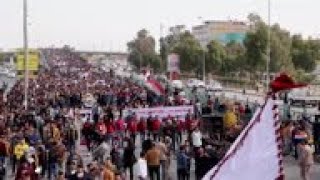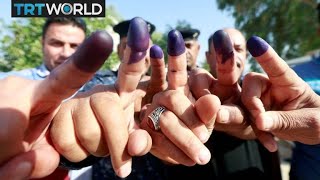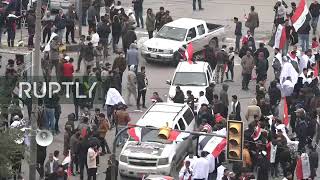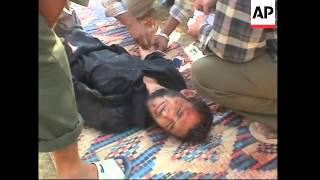Sunday, 23 November, 2025г.
















Где искать: по сайтам Запорожской области, статьи, видео ролики
пример: покупка автомобиля в Запорожье
Shiites gather for march onto Najaf
Hai al-Amal district, Baghdad, Iraq
1. Group of men chant support for Grand Ayatollah Ali Husseini al-Sistani
2. Pilgrims get on bus
3. Interior of bus, pilgrims climb in
4. Pilgrims chant inside bus
5. Chanting pilgrims hold up poster of al-Sistani
Sadr City, Baghdad, Iraq
6. Men on back of truck using loudspeakers to call for pilgrims to go to Najaf
7. Group of people waiting by road
8. Man decorates coach with posters of al-Sistani
9. People getting on coach
10. Coaches leaving
Kufa, near Najaf
11. Wide of mosque
12. Various of crowd outside mosque with posters of Muqtada al-Sadr and al-Sistani
13. SOUNDBITE: (Arabic) Sheik Ja'far Edaksi, cleric
"Today we came as a response to the blessed call to stop the bloodshed in the holy city of Najaf which has been desecrated. What crimes have the people of Najaf committed that the holy city be defiled?"
17. Posters of al-Sadr and al-Sistani
18. Pilgrims arrive
STORYLINE:
Iraq's most powerful Shiite cleric arrived home from Britain on Wednesday and his aides called for a nationwide march to Najaf to end nearly three weeks of fierce fighting between U.S. forces and Shiite militants in the holy city.
Grand Ayatollah Ali Husseini al-Sistani is heading to Najaf "to stop the bloodshed," said Al-Sayyid Murtadha Al-Kashmiri, an al-Sistani representative in London. "Those believers who wish to join him, let them join," he said.
In Shiite areas across Iraq, appeals issued from mosque loudspeakers urging Iraqis to heed al-Sistani's call. In the Baghdad districts of Sadr City and Hai al-Amal, many left for Najaf in cars and buses.
In honour of al-Sistani's arrival, militants loyal to radical Shiite cleric Muqtada al-Sadr said they would suspend fighting with coalition and Iraqi forces in every region al-Sistani passes through on his way to Najaf, said al-Sadr aide Aws al-Khafaji.
Heavy fighting has persisted in Najaf's Old City, the centre of much of the past three weeks of clashes.
U.S. warplanes fired on the neighbourhood, helicopters flew overhead and heavy gunfire was heard in the streets, witnesses said.
Witnesses in the Old City said militants were still fighting in the streets, though the relentless American attacks appeared to be weakening them.
Al-Sistani, 73, had been in London for medical treatment since 6 August, one day after clashes erupted in Najaf. The cleric wields enormous influence among Shiite Iraqis and his return could play a crucial role in stabilising the crisis.
Interim Prime Minister Ayad Allawi's office issued a statement welcoming al-Sistani back "on behalf of all Iraqis."
He crossed into southern Iraq from Kuwait at around noon in a caravan of sport utility vehicles accompanied by Iraqi police and national guardsmen.
The convoy stopped in Basra where al-Sistani met the city's governor, Hassan al-Rashid who told reporters that the cleric would lead a march to Najaf on Thursday.
"The masses will gather at the outskirts of Najaf and they will not enter the city until all armed men, except the Iraqi policemen, withdraw from the city," he said.
You can license this story through AP Archive: http://www.aparchive.com/metadata/youtube/ab91a9e9a44e4c77b97d0b78e8702b66
Find out more about AP Archive: http://www.aparchive.com/HowWeWork
Теги:
AP Archive 426130 ab91a9e9a44e4c77b97d0b78e8702b66 Iraq Shiites Muqtada al-Sadr Ayad Allawi Baghdad Iraq London Middle East England United Kingdom Western Europe Social affairs
Похожие видео
Мой аккаунт


 У вашего броузера проблема в совместимости с HTML5
У вашего броузера проблема в совместимости с HTML5


